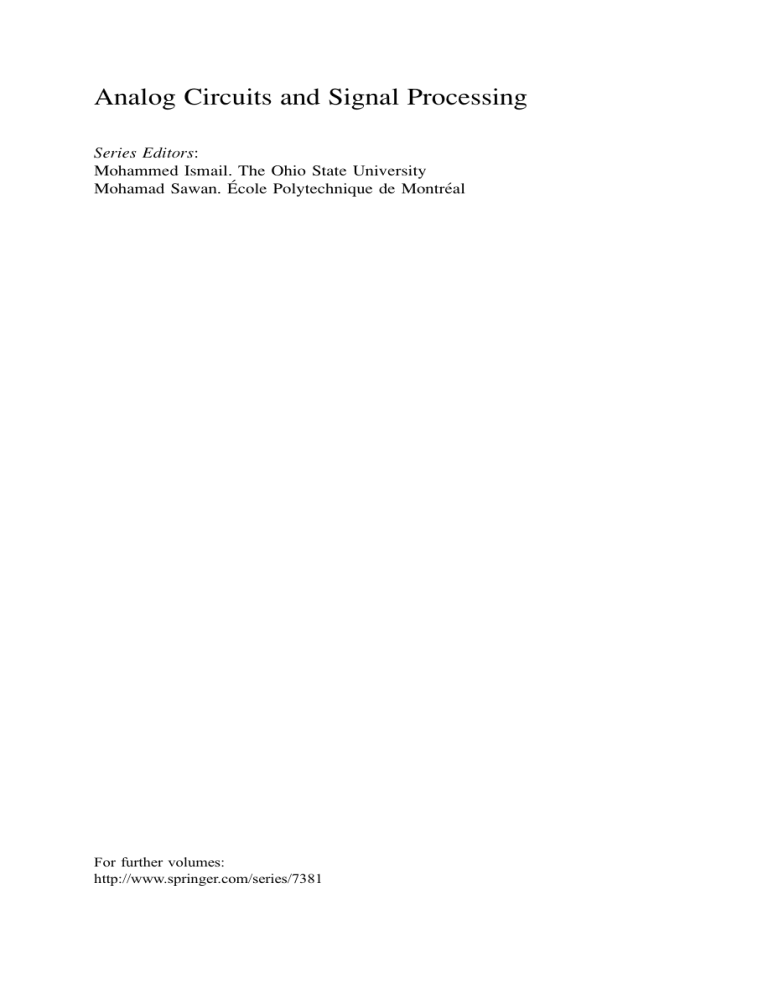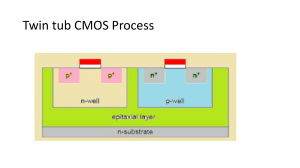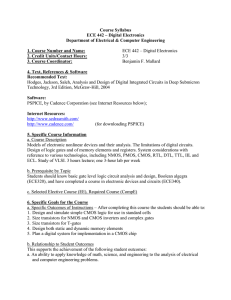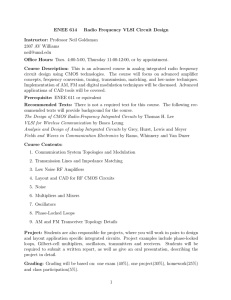Mak and Martins - 2012 - High-Mixed-Voltage Analog and RF Circuit Techniqu
advertisement

Analog Circuits and Signal Processing Series Editors: Mohammed Ismail. The Ohio State University Mohamad Sawan. École Polytechnique de Montréal For further volumes: http://www.springer.com/series/7381 Pui-In Mak Rui Paulo Martins High-/Mixed-Voltage Analog and RF Circuit Techniques for Nanoscale CMOS Pui-In Mak University of Macau Taipa, Macao, China Rui Paulo Martins University of Macau Taipa, Macao, China ISBN 978-1-4419-9538-4 ISBN 978-1-4419-9539-1 (eBook) DOI 10.1007/978-1-4419-9539-1 Springer New York Heidelberg Dordrecht London Library of Congress Control Number: 2012933993 # Springer Science+Business Media New York 2012 This work is subject to copyright. All rights are reserved by the Publisher, whether the whole or part of the material is concerned, specifically the rights of translation, reprinting, reuse of illustrations, recitation, broadcasting, reproduction on microfilms or in any other physical way, and transmission or information storage and retrieval, electronic adaptation, computer software, or by similar or dissimilar methodology now known or hereafter developed. Exempted from this legal reservation are brief excerpts in connection with reviews or scholarly analysis or material supplied specifically for the purpose of being entered and executed on a computer system, for exclusive use by the purchaser of the work. Duplication of this publication or parts thereof is permitted only under the provisions of the Copyright Law of the Publisher’s location, in its current version, and permission for use must always be obtained from Springer. Permissions for use may be obtained through RightsLink at the Copyright Clearance Center. Violations are liable to prosecution under the respective Copyright Law. The use of general descriptive names, registered names, trademarks, service marks, etc. in this publication does not imply, even in the absence of a specific statement, that such names are exempt from the relevant protective laws and regulations and therefore free for general use. While the advice and information in this book are believed to be true and accurate at the date of publication, neither the authors nor the editors nor the publisher can accept any legal responsibility for any errors or omissions that may be made. The publisher makes no warranty, express or implied, with respect to the material contained herein. Printed on acid-free paper Springer is part of Springer Science+Business Media (www.springer.com) Weng-Ieng & Long-Cheng Dita & Filipa, Diogo, Guilherme e Maria Preface The scope of more intelligent and higher data rate wireless connectivity in the coming decades continuously push the performance envelope of wireless circuits and systems. Higher integration level, more functionality, less cost and lower power are the obvious goals. For the radio front-ends, inductorless broadband solutions possess the highest potential to economically realize low-power multi-standard solutions in nm-length CMOS technologies. The rapid downscaling of transistor sizes and gate-oxide thickness, however, involves rapid reduction of supply voltage for reliability. This fact, in addition to the changed device features such as lower intrinsic gain and linearity, urges for more feasible techniques from different dimensions, such that the performances can be aligned continuously with the expectation from the global wireless chip industry. In this book, high-/mixed-voltage analog and RF circuits are investigated as the prospective solution for the next generation of wireless products in nm-length CMOS technologies. The content starts by overviewing the design considerations, pros and cons of high-/mixed-voltage circuits before describing three tailor-made circuit designs targeting the mobile-TV applications. Mobile TV is recognized as one of the key functions of handheld devices such as smart phones. The first design is a 90-nm CMOS ultra-wideband low-noise amplifier with mixedvoltage ESD protection for handling the full-band of mobile TV. The second is a 90-nm CMOS high-voltage-enabled mobile-TV RF front-end with TV-GSM interoperability. The third is a 65-nm CMOS mixed-voltage unified full-band mobile-TV receiver frontend averting any external balun, while measuring favorably performances with respect to the state-of-the-art. Most techniques are generally extendable to different types of wireless systems in ultra-scaled CMOS technologies. Taipa, Macao, China Pui-In Mak Rui Paulo Martins vii Acknowledgments We are grateful to Macao Science and Technology Development Fund (FDCT) and Research Committee of University of Macau (UM), for funding the project and equipments of the State Key Laboratory of Analog and Mixed-Signal VLSI. We thank Mr. Ka-Fai Un and Miao Liu for their contribution to the design of the multi-phase local oscillator generator and high-voltage amplifier, respectively. We thank the staff at Springer, particularly Chuck Glaser, for guiding the preparation of this book. Finally, we send our heartfelt appreciation to our families, who endured our dedication to this book. ix Contents 1 Introduction. . . . . . . . . . . . . . . . . . . . . . . . . . . . . . . . . . . . . . . . . . . . . . . . . . . . . . . . . . . . . . . . . 1.1 The Global Development of Wireless Technologies . . . . . . . . . . . . . . . . . 1.2 Analog and RF Circuits in Nanoscale CMOS . . . . . . . . . . . . . . . . . . . . . . . . 1.3 Research Objectives. . . . . . . . . . . . . . . . . . . . . . . . . . . . . . . . . . . . . . . . . . . . . . . . . . . 1.4 Organization of the Book . . . . . . . . . . . . . . . . . . . . . . . . . . . . . . . . . . . . . . . . . . . . . References. . . . . . . . . . . . . . . . . . . . . . . . . . . . . . . . . . . . . . . . . . . . . . . . . . . . . . . . . . . . . . . . . . . 2 General Considerations of High-/Mixed-VDD Analog and RF Circuits and Systems. . . . . . . . . . . . . . . . . . . . . . . . . . . . . . . . . . . . . . . . . . . . . . 2.1 Introduction. . . . . . . . . . . . . . . . . . . . . . . . . . . . . . . . . . . . . . . . . . . . . . . . . . . . . . . . . . . . 2.2 System Considerations . . . . . . . . . . . . . . . . . . . . . . . . . . . . . . . . . . . . . . . . . . . . . . . . 2.3 Device Reliability in Ultra-scaled Processes . . . . . . . . . . . . . . . . . . . . . . . . . 2.3.1 AMR . . . . . . . . . . . . . . . . . . . . . . . . . . . . . . . . . . . . . . . . . . . . . . . . . . . . . . . . . . 2.3.2 HCI Lifetime . . . . . . . . . . . . . . . . . . . . . . . . . . . . . . . . . . . . . . . . . . . . . . . . . . 2.3.3 TDDB . . . . . . . . . . . . . . . . . . . . . . . . . . . . . . . . . . . . . . . . . . . . . . . . . . . . . . . . . 2.3.4 NBTI . . . . . . . . . . . . . . . . . . . . . . . . . . . . . . . . . . . . . . . . . . . . . . . . . . . . . . . . . . 2.3.5 Punchthrough. . . . . . . . . . . . . . . . . . . . . . . . . . . . . . . . . . . . . . . . . . . . . . . . . . 2.4 Extend the Voltage Capability of Thinand Thick-Oxide Transistors. . . . . . . . . . . . . . . . . . . . . . . . . . . . . . . . . . . . . . . . . . 2.5 High-/Mixed-Voltage Building Blocks . . . . . . . . . . . . . . . . . . . . . . . . . . . . . . . 2.5.1 Power Amplifier and Wideband Balun-LNA (High-VDD þ Mixed-Transistor) . . . . . . . . . . . . . . . . . . . . . . . . . . . . . 2.5.2 Passive Mixers (High-VDD þ Thin-Oxide Transistor) . . . . . . . 2.5.3 Differential Pair (High-VDD þ Thin-Oxide Transistor) . . . . . . 2.5.4 Recycling Folded Cascode Operational Amplifier (High-VDD þ Thin-Oxide Transistor) . . . . . . . . . . . . . . . . . . . . . . . . 2.5.5 OpAmp-Based Analog-Baseband Circuits (Mixed-VDD þ Mixed-Transistor) . . . . . . . . . . . . . . . . . . . . . . . . . . . . 2.5.6 Low-Dropout-Regulator (Mixed-VDD þ Mixed-Transistor) . . . . . . . . . . . . . . . . . . . . . . . . . . . . 1 1 2 2 6 7 9 9 9 11 11 11 11 12 12 12 14 14 15 17 18 27 29 xi xii Contents 2.5.7 Sample-and-Hold Amplifier (High-VDD þ Mixed-Transistor) . . . . . . . . . . . . . . . . . . . . . . . . . . . . . 2.5.8 Line Driver (High-VDD þ Thin-Oxide Transistor). . . . . . . . . . . 2.6 Summary . . . . . . . . . . . . . . . . . . . . . . . . . . . . . . . . . . . . . . . . . . . . . . . . . . . . . . . . . . . . . . References. . . . . . . . . . . . . . . . . . . . . . . . . . . . . . . . . . . . . . . . . . . . . . . . . . . . . . . . . . . . . . . . . . . 3 4 5 31 32 33 33 A Full-Band Mobile-TV LNA with Mixed-Voltage ESD Protection in 90-nm CMOS. . . . . . . . . . . . . . . . . . . . . . . . . . . . . . . . . . . . . . . . . . 3.1 Introduction. . . . . . . . . . . . . . . . . . . . . . . . . . . . . . . . . . . . . . . . . . . . . . . . . . . . . . . . . . . . 3.2 Circuit Description . . . . . . . . . . . . . . . . . . . . . . . . . . . . . . . . . . . . . . . . . . . . . . . . . . . . 3.2.1 Full-Band Mobile-TV Tuner Architecture . . . . . . . . . . . . . . . . . . . 3.2.2 PMOS-Based Open-Source Input Structure and Mixed-Voltage ESD Protection . . . . . . . . . . . . . . . . . . . . . . . . . . 3.2.3 Double Current Reuse for gm-Enhancement. . . . . . . . . . . . . . . . . . 3.2.4 Single-Stage Thermal-Noise Cancellation. . . . . . . . . . . . . . . . . . . . 3.3 Key Practical Design Issues. . . . . . . . . . . . . . . . . . . . . . . . . . . . . . . . . . . . . . . . . . . 3.3.1 Package Effect on Input Impedance Match . . . . . . . . . . . . . . . . . . 3.3.2 Self-Startup Constant-gm Bias Circuit . . . . . . . . . . . . . . . . . . . . . . . . 3.3.3 Power-Up/Down Control with Reliability Concern . . . . . . . . . . 3.3.4 Mixed-Voltage ESD Protection Scheme . . . . . . . . . . . . . . . . . . . . . 3.4 Simulation Results, Discussions and Benchmarks. . . . . . . . . . . . . . . . . . . . 3.5 Summary . . . . . . . . . . . . . . . . . . . . . . . . . . . . . . . . . . . . . . . . . . . . . . . . . . . . . . . . . . . . . . References. . . . . . . . . . . . . . . . . . . . . . . . . . . . . . . . . . . . . . . . . . . . . . . . . . . . . . . . . . . . . . . . . . . 36 39 41 43 43 44 45 45 46 51 53 A High-Voltage-Enabled Mobile-TV RF Front-End in 90-nm CMOS. . . . . . . . . . . . . . . . . . . . . . . . . . . . . . . . . . . . . . . . . . . . . . . . . . . . . . . . . . . . 4.1 Introduction. . . . . . . . . . . . . . . . . . . . . . . . . . . . . . . . . . . . . . . . . . . . . . . . . . . . . . . . . . . . 4.2 Tuner Architecture for TV-GSM Interoperation. . . . . . . . . . . . . . . . . . . . . . 4.3 On/Off-Chip Circuit Design . . . . . . . . . . . . . . . . . . . . . . . . . . . . . . . . . . . . . . . . . . 4.3.1 Basic-Cell of the LNA . . . . . . . . . . . . . . . . . . . . . . . . . . . . . . . . . . . . . . . . 4.3.2 ESD Protection Scheme. . . . . . . . . . . . . . . . . . . . . . . . . . . . . . . . . . . . . . . 4.3.3 Programmable C-2C Attenuator . . . . . . . . . . . . . . . . . . . . . . . . . . . . . . 4.3.4 I/Q Mixer Drivers . . . . . . . . . . . . . . . . . . . . . . . . . . . . . . . . . . . . . . . . . . . . . 4.3.5 Customized External Preselect Filters . . . . . . . . . . . . . . . . . . . . . . . . 4.3.6 Feedforward Gain Roll-Off Compensation . . . . . . . . . . . . . . . . . . . 4.4 Experimental Results, Discussions and Benchmarks. . . . . . . . . . . . . . . . . 4.5 Summary . . . . . . . . . . . . . . . . . . . . . . . . . . . . . . . . . . . . . . . . . . . . . . . . . . . . . . . . . . . . . . References. . . . . . . . . . . . . . . . . . . . . . . . . . . . . . . . . . . . . . . . . . . . . . . . . . . . . . . . . . . . . . . . . . . 55 55 55 58 58 64 64 68 70 72 73 78 78 A Mixed-Voltage Unified Receiver Front-End for Full-Band Mobile TV in 65-nm CMOS. . . . . . . . . . . . . . . . . . . . . . . . . . . . . . . . . . . . . . . . . . . . . . . 5.1 Introduction. . . . . . . . . . . . . . . . . . . . . . . . . . . . . . . . . . . . . . . . . . . . . . . . . . . . . . . . . . . . 5.2 RFE Architecture and Technology Features. . . . . . . . . . . . . . . . . . . . . . . . . . 5.3 Wideband Balun-LNA . . . . . . . . . . . . . . . . . . . . . . . . . . . . . . . . . . . . . . . . . . . . . . 81 81 83 84 35 35 36 36 Contents xiii 5.3.1 5.3.2 CG-CS Noise-Canceling Balun-LNA . . . . . . . . . . . . . . . . . . . . . . Proposed Gain-Boosting Current-Balancing Balun-LNA with VGC . . . . . . . . . . . . . . . . . . . . . . . . . . . . . . . . . . . . . . 5.4 Current-Reuse Mixer-LPF . . . . . . . . . . . . . . . . . . . . . . . . . . . . . . . . . . . . . . . . . . 5.4.1 Circuit Description . . . . . . . . . . . . . . . . . . . . . . . . . . . . . . . . . . . . . . . . . . 5.4.2 Noise Figure. . . . . . . . . . . . . . . . . . . . . . . . . . . . . . . . . . . . . . . . . . . . . . . . . 5.4.3 Simulation Results . . . . . . . . . . . . . . . . . . . . . . . . . . . . . . . . . . . . . . . . . . 5.5 Multi-phase LOG. . . . . . . . . . . . . . . . . . . . . . . . . . . . . . . . . . . . . . . . . . . . . . . . . . . . 5.5.1 Brief Overview. . . . . . . . . . . . . . . . . . . . . . . . . . . . . . . . . . . . . . . . . . . . . . 5.5.2 Open Loop Multi-phase LO Generators (Conventional and Proposed) . . . . . . . . . . . . . . . . . . . . . . . . . . . . . . . 5.5.3 Circuit Implementation and Simulation Results. . . . . . . . . . . . 5.6 Measurement Results. . . . . . . . . . . . . . . . . . . . . . . . . . . . . . . . . . . . . . . . . . . . . . . . 5.6.1 The RFE. . . . . . . . . . . . . . . . . . . . . . . . . . . . . . . . . . . . . . . . . . . . . . . . . . . . . 5.6.2 The LOG . . . . . . . . . . . . . . . . . . . . . . . . . . . . . . . . . . . . . . . . . . . . . . . . . . . . 5.6.3 Performance Comparison . . . . . . . . . . . . . . . . . . . . . . . . . . . . . . . . . . . 5.6.4 Architecture Comparison . . . . . . . . . . . . . . . . . . . . . . . . . . . . . . . . . . . 5.7 Summary . . . . . . . . . . . . . . . . . . . . . . . . . . . . . . . . . . . . . . . . . . . . . . . . . . . . . . . . . . . . References. . . . . . . . . . . . . . . . . . . . . . . . . . . . . . . . . . . . . . . . . . . . . . . . . . . . . . . . . . . . . . . . . 103 105 108 109 113 113 115 117 118 Conclusions. . . . . . . . . . . . . . . . . . . . . . . . . . . . . . . . . . . . . . . . . . . . . . . . . . . . . . . . . . . . . . . 6.1 Concluding Remarks . . . . . . . . . . . . . . . . . . . . . . . . . . . . . . . . . . . . . . . . . . . . . . . . 6.2 Recommendations for Future Research. . . . . . . . . . . . . . . . . . . . . . . . . . . . . 121 121 122 Appendix: Open-Loop Multiphase LO Generators . . . . . . . . . . . . . . . . . . . . . . . 125 Index . . . . . . . . . . . . . . . . . . . . . . . . . . . . . . . . . . . . . . . . . . . . . . . . . . . . . . . . . . . . . . . . . . . . . . . . . . 143 6 84 85 96 96 100 101 102 102 Abbreviations 1/f AC ADC (A/D) AMR ATT Flicker noise Alternating current Analog-to-digital converter Absolute maximum rating Attenuator BB BiCMOS BPF BSF BTI BUF BW Baseband Bipolar complementary metal oxide semiconductor Bandpass filter Band-selection filter Bias temperature instability Buffer Bandwidth CG CG CLKGEN CM CMFB CMOS CMRR CQFP CS CSF CT Conversion gain Common-gate Clock generator Common mode Common mode feedback Complementary metal oxide semiconductor Common-mode rejection ratio Ceramic quad flat-pack Common-source Channel-selection filter Continuous-time DC DMB-T DRC DSB DSP DVB-T/H Direct current Digital multimedia broadcasting-terrestrial Design rule check Double-side band Digital signal processor Digital video broadcasting-terrestrial/handheld xv xvi Abbreviations ESD Electrostatic discharge FET FF FS FS Field effect transistor Fast-fast (corner) Fast-slow (corner) Frequency synthesizer GBW GSM Gain-bandwidth product Global system for mobile communications HBM HCI HD2/HD3 HPF HR/HRR Human body model Hot carrier injection Second-/third-order harmonic distortion Highpass filter Harmonic rejection (ratio) I I/P IC IEEE IIR IM3 IP3 IRR ISDB-T ISM ISSCC I-to-V In phase Input Integrated circuit Institute of electrical and electronics engineering Infinite-impulse response Third-order intermodulation distortion Third-order intercept point Image-rejection ratio Integrated services digital broadcasting-terrestrial Industrial, scientific and medical IEEE international solid-state circuits conference Current-to-voltage JSSC IEEE journal of solid-state circuits LDO LIF LNA LO LOG LPF LTCC LV LVS Low-dropout regulator Low IF Low-noise amplifier Local oscillator Local oscillator generator Lowpass filter Low-temperature co-fired ceramic Low voltage Layout versus schematic MOSFET Metal-oxide semiconductor field-effect transistor NF Noise figure O/P OFDM OpAmp OTA Output Orthogonal frequency-division multiplexing Operational amplifier Operational transconductance amplifier Abbreviations xvii PCB PLL PM PVT Printed-circuit board Phase-locked loop Phase margin Process, supply voltage and temperature Q QAM Quadrature phase/quality factor Quadrature amplitude modulation RC RF RFE RX Resistor-capacitor Radio frequency Receiver front-end Receiver S2D SAW SF SFDR SoC SS Single-to-differential Surface acoustic wave Slow-fast (corner) Spurious-free dynamic range System-on-chip Slow-slow (corner) TDDB T-DMB TX TXR Time dependent dielectric breakdown Terrestrial-digital multimedia broadcasting Transmitter Transceiver UHF UWB Ultra-high frequency Ultra wideband VCO VGC VHF V-to-I Voltage control oscillator Variable gain control Very-high frequency Voltage-to-current WLAN Wireless local area network ZIF Zero IF




